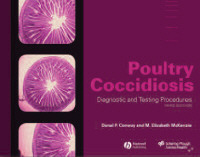Updated coccidiosis book addresses value of vaccination
A popular book on coccidiosis has been updated to include a new chapter on anticoccidial drugs and vaccines.
The 165-page book, Poultry Coccidiosis: Diagnostic and
Testing Procedures, is authored by veterinary parasitologists
Donal Conway and M. Elizabeth McKenzie. When it was first
released in 1979 and a second edition was published in 1991,
the book was found to be very useful for poultry scientists, disease
diagnosticians and veterinarians.
The most recent edition reflects substantial progress in
knowledge about coccidiosis in poultry and a growing body of
critical information, Conway says.
The book includes an introduction to coccidiosis, reviews
diagnostic procedures and collection
and counting of oocysts. It
also contains basic procedures
and example protocols for testing
anticoccidial drugs.
There is a tutorial on scoring
gross lesions caused by major
species of Eimeria infecting
chickens. The review is based on
the Johnson and Reid lesion scoring
procedure.
For each species, lesions due
to infections ranging from light to
severe are illustrated by highquality
images.
"Over the years, these images
have been of significant value in
assessing the importance and
severity of both controlled and
naturally occurring coccidial
infections, and it is a special
delight to us to review these
images once again," Conway
comments.

Vaccines minimize resistance
In a chapter on the epidemiology
and control of coccidiosis,
Conway and McKenzie state that the use of anticoccidial vaccines
in a rotational program with anticoccidial drugs is recommended
to minimize the risk of anticoccidial drug tolerance or
resistance problems over the long term.
"The use of anticoccidial vaccines in breeders and replacement
birds is probably the optimum course in most situations,
and the current ability to vaccinate chicks at the hatchery by
spray cabinet... has made a big difference in making anticoccidial
vaccines a practical option for broiler chickens as
well," say the authors, who also cover important topics such as
environmental management and feed quality.
The book's new chapter on anticoccidial drugs and vaccines
reviews various anticoccidials and provides a review of each
drug's chemical structure, safety and efficacy. It contains an
interesting history on the development of polyether
ionophorous antibiotics, reviews the advantages of these drugs
and includes concerns such as ionophore toxicity.
Vaccines a 'practical alternative'
Vaccines, the authors state, "provide a very practical and
important alternative to the exclusive use of anticoccidial drugs
for two excellent reasons."
A number of studies have demonstrated that vaccines give a
comparable level of coccidiosis protection to growing broiler
chickens compared to anticoccidial drug programs and most
live vaccines replace indigenous coccidial populations in the
broiler house with coccidia that are susceptible to anticoccidial
drugs, extending the usefulness of anticoccidials, they say.
Although initial application of live vaccines was limited to
layers and broiler breeders, there is currently a growing use of
live anticoccidial vaccines in broiler chickens due in large part
to the ability to apply vaccines in an economically effective
way at the hatchery, the authors say.
In a section on Coccivac vaccines, Conway and McKenzie
explain that the vaccines deliver a controlled dose of oocysts
that induce sufficient infection to produce an appropriate
immune response without causing a pathogenic effect after
two or three life cycles of coccidia. Administration of the vaccine
with the SprayCox cabinet has enhanced the uniformity of
initial application, "vastly improving the vaccination response,
and making other methods of vaccination such as feed spray,
drinking water application, and eye spray methods much less
efficient."
The updated book will be available through Blackwell
Publishing Professional, 2121 State Avenue, Ames, IA 50014-
8300, USA, or through its website: www.blackwellprofessional.
com or www.blackwellvet.com.







